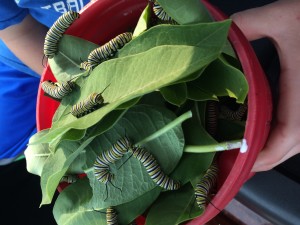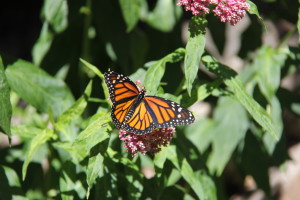If the local butterfly population could have a vote, they would likely award the Dwinnell family as St. Michael-Albertville’s family of the year. This family has been giving the monarch butterfly population a leg up for the past five years now, releasing over 400 this summer alone, and they have plans to help the declining species even more.
 Chuck and Kari, along with their three children, developed an interest in monarch butterflies five years ago after hearing of a friend’s similar project. They had heard about the steep decline in the monarch population – 9-year-old Andrew said the population has shrunk from one billion to around 33 million monarchs – and decided they wanted to do their part to bring that number back up. Monarch Watch, a nonprofit educational outreach program, said land development in the United States is a contributing factor to the decline of the monarchs, with 6,000 acres of monarch habitat consumed per day by development. Monarch Watch said that big changes are needed to restore butterfly habitat along America’s roadways and open areas, but combined individual efforts can create meaningful improvement as well.
Chuck and Kari, along with their three children, developed an interest in monarch butterflies five years ago after hearing of a friend’s similar project. They had heard about the steep decline in the monarch population – 9-year-old Andrew said the population has shrunk from one billion to around 33 million monarchs – and decided they wanted to do their part to bring that number back up. Monarch Watch, a nonprofit educational outreach program, said land development in the United States is a contributing factor to the decline of the monarchs, with 6,000 acres of monarch habitat consumed per day by development. Monarch Watch said that big changes are needed to restore butterfly habitat along America’s roadways and open areas, but combined individual efforts can create meaningful improvement as well.
Chuck built cages where the caterpillars can morph into chrysalis and then butterflies. This is called hand-raising, and it increases the insect’s survival rate. Then they and their three children started planting milkweed, which is the monarch’s food and egg-laying plant, planting flowers the butterflies are attracted to, such as purple coneflowers, hunting caterpillars and feeding the hungry little guys. The family estimates they spend almost 10 hours per week feeding them, cleaning cages and hunting for caterpillars. And, for the grand finale, the Dwinnells release them into the wild once their transformation is complete. The family said about 20 butterflies emerged from their chrysalis per day last summer.
“When you let them go for the first time they don’t really know what to do, so they land on you,” Kari said. “They would congregate on a bush in the front yard until they were ready to go. They are so beautiful.”
The Dwinnell family has bigger butterfly projects on the horizon, as Kari plans to build an official butterfly habitat and have it registered with the National Wildlife Federation.
“They’ll never get to that 1 billion again, but hopefully the numbers will increase versus decline,” Kari said.
 This is kind of a family thing,” she added. “We do it every year, we enjoy it and we are trying to help do something good for the environment.”
This is kind of a family thing,” she added. “We do it every year, we enjoy it and we are trying to help do something good for the environment.”
The Dwinnell family has a large amount of milkweed seed to spare for those interested in planting some this fall. If interested, comment on the article and we will get some milkweed seed coming your way.
ECarlson says
Great Article! We are very interested in Milkweed.